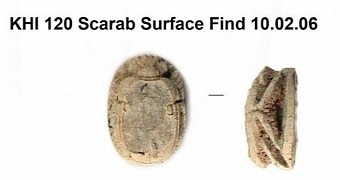An ancient Egyptian amulet shaped like a scarab beetle was not too long ago discovered in southern Jordan, at a site dubbed Khirbat Hamra Ifdan. Oddly enough, the artifact, pictured next to this article, was not unearthed during intense excavation activities.
On the contrary, word has it that a student spotted it lying on the ground and picked it up, Live Science informs. The student then handed it to Anthropology Professor Thomas E. Levy with the University of California, San Diego, who figured out what it was.
Not just a beetle-shaped amulet
According to Thomas E. Levy, the hieroglyphs inscribed on this beetle-shaped amulet are not some ancient Egyptian phrase for “YOLO” or anything of the sorts. On the contrary, they read as follows: “bright is the manifestation of Re, chosen of Amun/Re.”
In a paper in the journal Antiquity, the anthropology professor explains that the moniker inscribed on this artifact corresponds with the throne name of a pharaoh whose official name was Sheshonq I and who founded Egypt's 22nd dynasty.
“The hieroglyphic sequence reads ‘bright is the manifestation of Re, chosen of Amun/Re’ which corresponds with great certainty to the throne name of the founder of the Twenty-second Egyptian Dynasty, Sheshonq I.”
“This is only the second epigraphic attestation of Pharaoh Sheshonq I ever discovered in Cis- and Transjordan,” the University of California, San Diego, specialist and fellow researcher write in the paper describing this amulet.
The amulet is made of a mineral dubbed enstatite. Its predominant color is light brown, although traces of green are also visible. Size-wise, the artifact is by no means all that impressive. Thus, it measures 12.7 millimeters in length, 9.2 millimeters in width, and 5.5 millimeters in height.
The importance of this find
It is believed that, during his reign, pharaoh Sheshonq I waged a military campaign in present-day southern Jordan. However, bullet-proof evidence confirming these claims has not yet been discovered. The way Thomas E. Levy and colleagues see things, this beetle-shaped amulet might just be the proof archaeologists have been looking to find for quite a while now.
Thus, the researchers say that, although several other scarabs dating back to the time of the founder of Egypt's 22nd dynasty have been unearthed in the region over the years, this is the first to constitute written evidence of Sheshonq I's presence in the region.
“The discovery of the Sheshonq I scarab in Jordan’s Faynan copper ore resource zone raises new research questions concerning the geopolitical aims of the Twenty-second Dynasty’s campaign in the southern Levant,” the specialists explain in their paper.
It is believed that, during this military campaign, the pharaoh had his troops invade the region for the sole purpose of disrupting industrial copper production. This invasion is estimated to have taken place about 3,000 years ago, shortly after the death of King Solomon.

 14 DAY TRIAL //
14 DAY TRIAL //